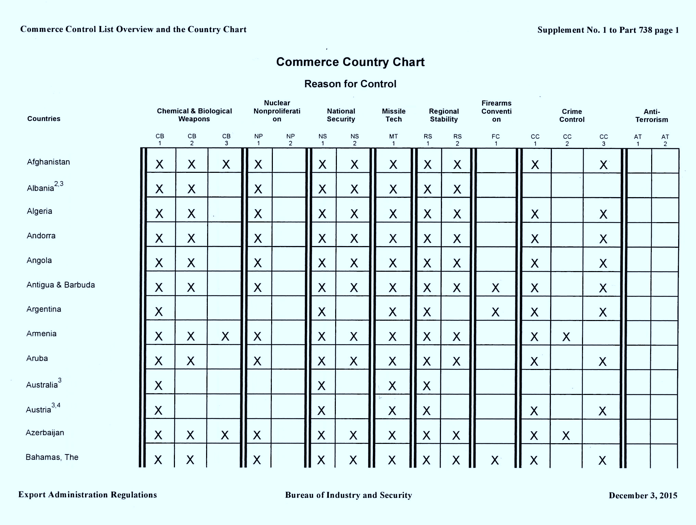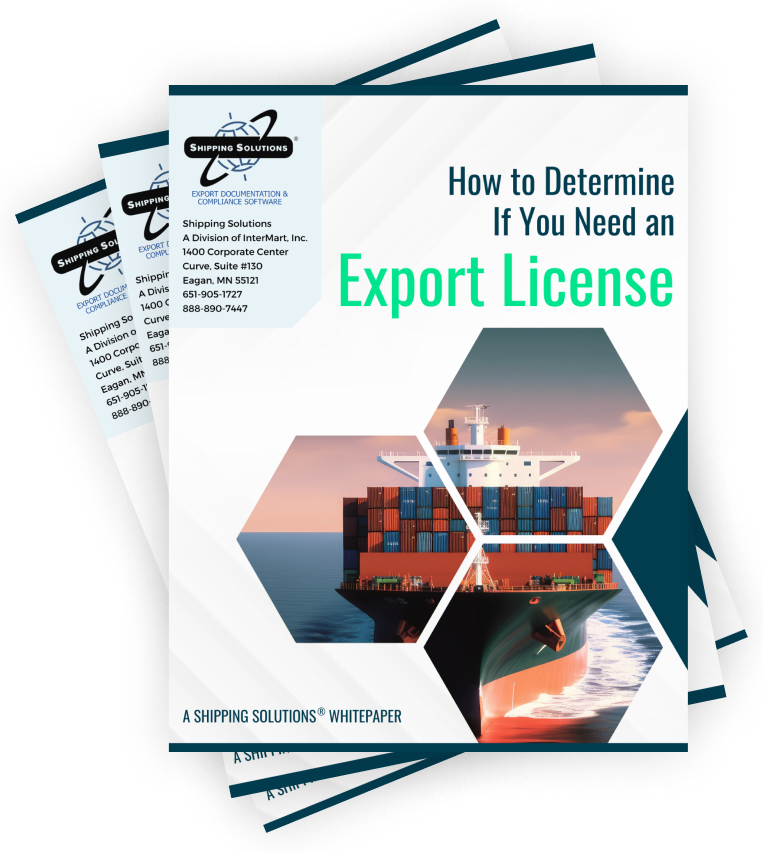The International Trade Blog Export Compliance
Using the Commerce Country Chart to Determine If You Need an Export License
On: January 15, 2024 | By:  Arnesh Roy |
5 min. read
Arnesh Roy |
5 min. read
 In a previous blog post, I discussed what I had learned by attending a seminar cosponsored by the Bureau of Industry and Security (BIS) and the Minnesota Trade Office. I described how to find an item’s Export Control Classification Number (ECCN) on the Commerce Control List (CCL).
In a previous blog post, I discussed what I had learned by attending a seminar cosponsored by the Bureau of Industry and Security (BIS) and the Minnesota Trade Office. I described how to find an item’s Export Control Classification Number (ECCN) on the Commerce Control List (CCL).
In today’s blog post, I will describe the next step in the process: How to use the Commerce Country Chart to determine if an export license is required based on the reasons for control.
The process I’m describing relates to items that fall under the jurisdiction of the U.S. Department of Commerce, which most goods do. Keep in mind, however, that the license determination process for products that fall under the jurisdiction of the State Department or another agency will be different. (If you don't know who has jurisdiction over your exports, read my blog post, Determining Export Controls Jurisdiction and Classification: ITAR and EAR Order of Review.)
Reasons for Export Control
There are four factors that go into determining whether or not you’ll need an export license:
- The technical characteristics of the item.
- The destination.
- The end user.
- The end use.
 For example, let’s say that I am looking to export parts and components made from fluorinated compounds to Algeria. First, I need to identify the correct ECCN for my product. Parts and components made from fluorinated compounds are listed under heading 1A001 in the CCL.
For example, let’s say that I am looking to export parts and components made from fluorinated compounds to Algeria. First, I need to identify the correct ECCN for my product. Parts and components made from fluorinated compounds are listed under heading 1A001 in the CCL.
After identifying the ECCN, I can see that there are certain license requirements for exporting the product. In this case, license codes NS and AT apply for the whole entry, and specifically for the Commerce Country Chart, NS Column 2 and AT Column 1 apply.
NS and AT are each reasons for control. NS stands for National Security, and AT stands for Anti-Terrorism.
Once I have obtained the export license code(s) for my item, I can find the corresponding column(s) on the Commerce Country Chart (see image below). Where the column meets the row for the country in question (in this case, Algeria) there will either be an “X” or the space will be left blank.
If there is an “X” in the box, this means that a license is required for exports to that particular country. If the space is blank and there is no “X”, this means that an export license is not required for a shipment to the country in question.

For this specific example, I can see that there is an “X” in the box where NS Column 2 meets the row for Algeria, and the space is left blank where AT Column 1 meets the row for Algeria. This means that I will need to obtain an export license for reasons of National Security.
Prohibited End Use and End Users
The BIS website has a section explaining how export licenses work. They state that if you as the exporter are aware that the items you are shipping will be ultimately sent to a prohibited end user or for a prohibited end use, you must obtain an export license. An example of a prohibited end use would be if the items that were shipped were ultimately used to further the proliferation of chemical, biological or nuclear weapons.
There are many prohibited end users, and some of these are listed in a consolidated screening list that combines the Departments of State, Treasury and Commerce lists and can be accessed on the BIS website.
The export compliance module in the Shipping Solutions Professional export documentation and compliance software, as well as the Restricted Party Screening Software, allow users to screen the contacts in their shipment against a consolidated list of restricted or denied parties that includes data from over one hundred lists produced by U.S. government agencies and international organizations. This list is consistently updated to ensure that the most up-to-date information is provided.
It is important to note that knowing the Schedule B code for your product will not help you determine the ECCN. The Schedule B code and the ECCN are separate and do not correlate. Just because you know the Schedule B code does not mean that you do not need to determine the product’s ECCN for export license requirements.
As stated in my previous blog post, items that are subject to the Export Administration Regulations (EAR) but are not specifically listed on the CCL are designated as EAR99 in place of an ECCN. The code NLR (No License Required) is normally used for such items, along with the corresponding license type, C33, which is not actually an export license itself but rather indicates that the product does not require a license.
The Export Compliance Module built into the Shipping Solutions Professional software includes an Export License Determination tool. This helps determine if an export license is required for your shipment, and if so, what kind of license and if there are any license exceptions available. Our Export Controls Trade Software will also perform this task, saving exporters the hassle of having to manually look through the Commerce Country Chart for each shipment.
Like what you read? Subscribe today to the International Trade Blog to get the latest news and tips for exporters and importers delivered to your inbox.
This article was first published in December 2016 and has been updated to include current information, links and formatting.

About the Author: Arnesh Roy
Arnesh Roy was a Senior Inside Sales Representative at Shipping Solutions.


